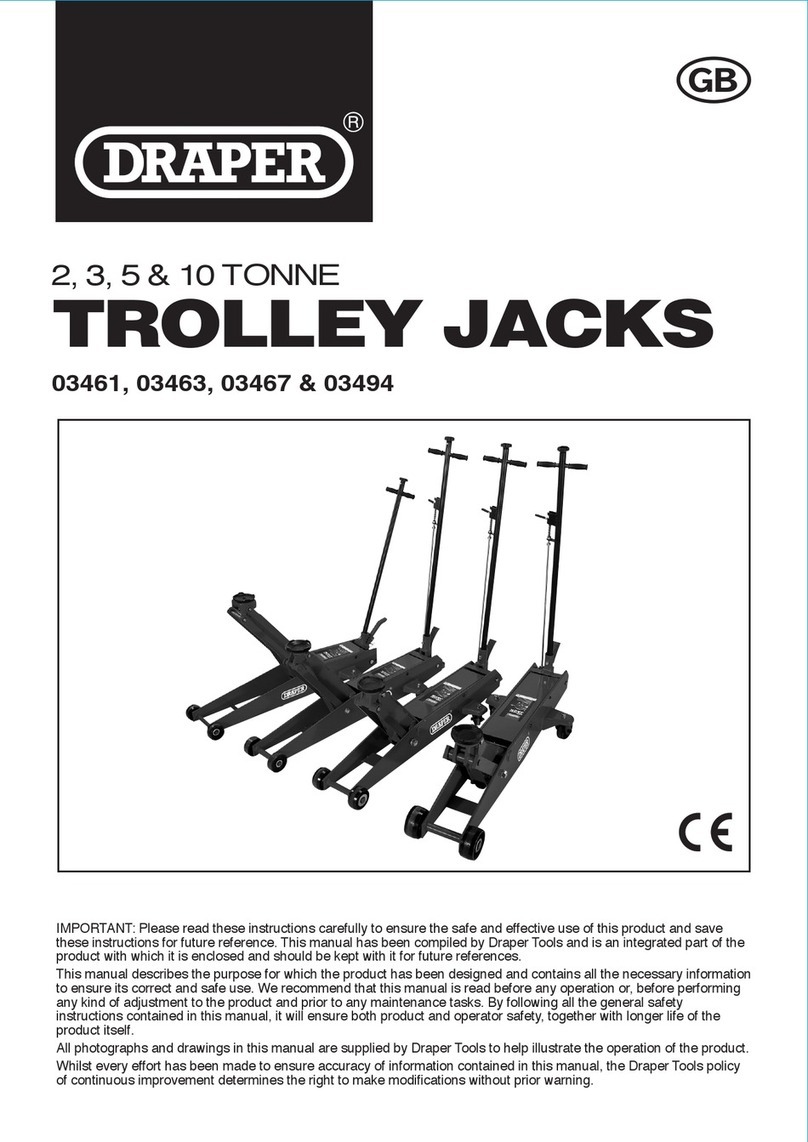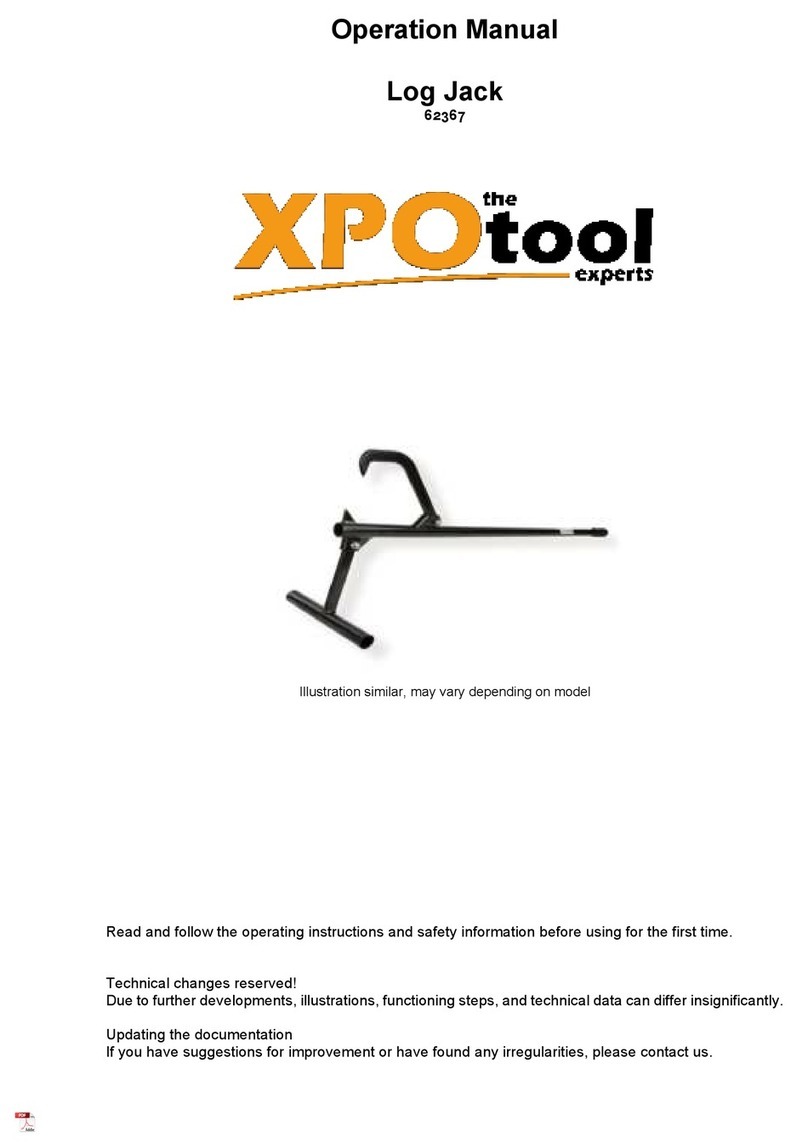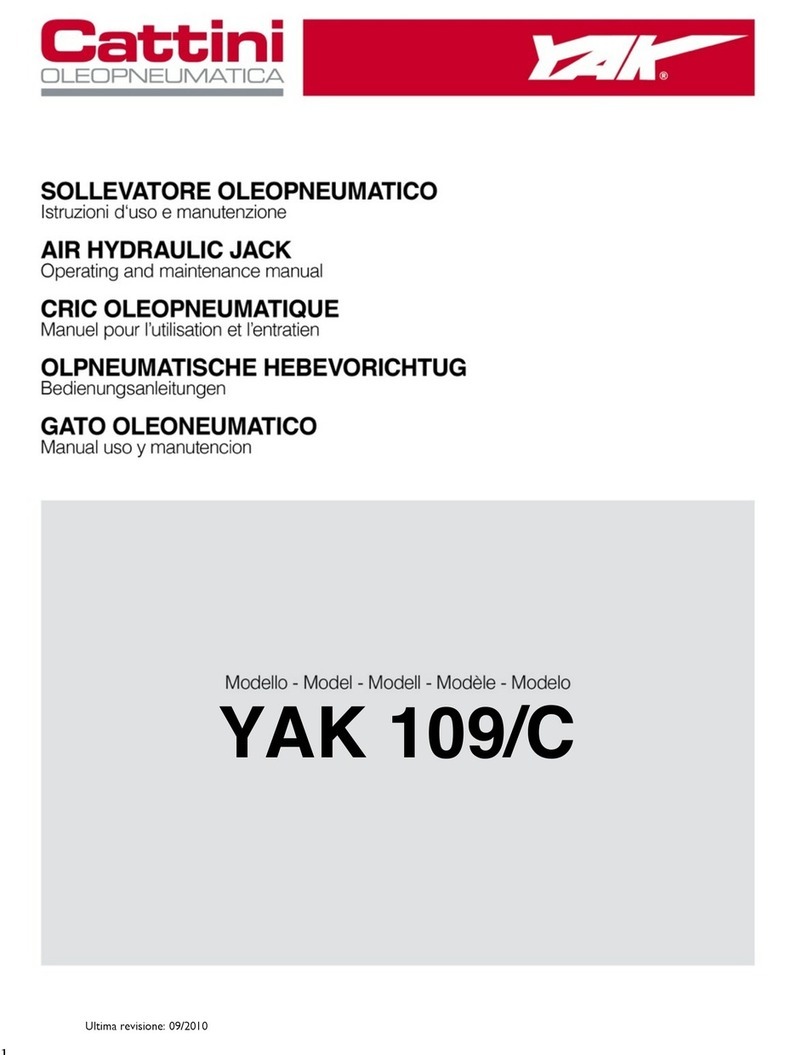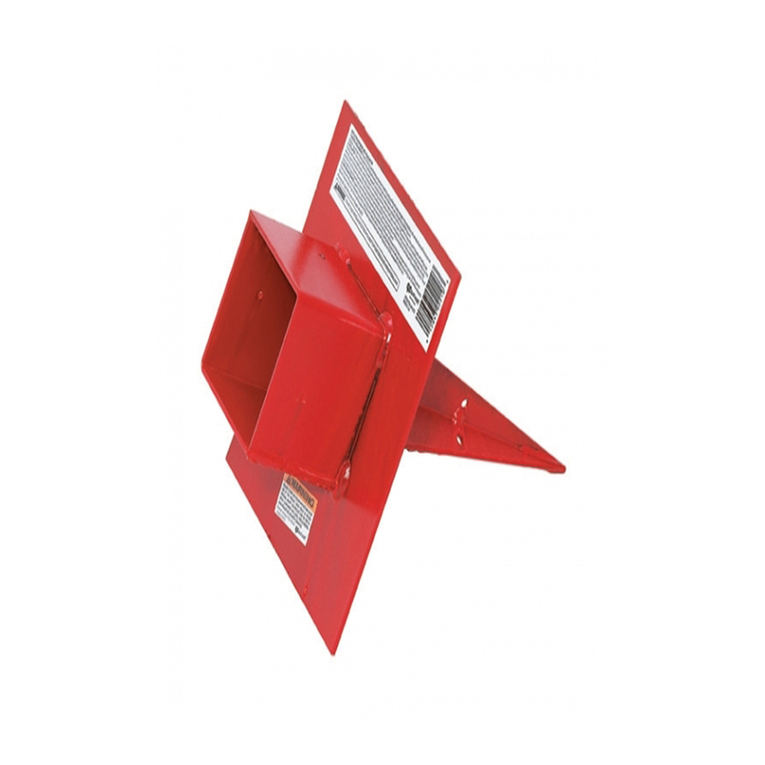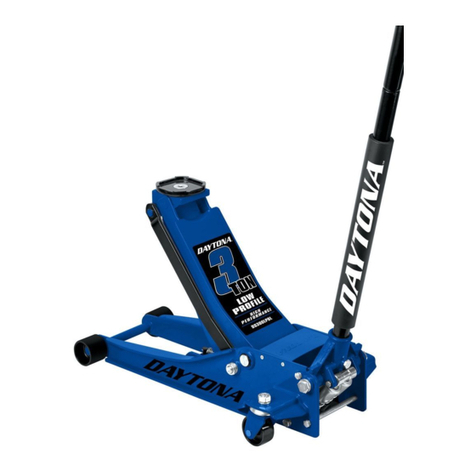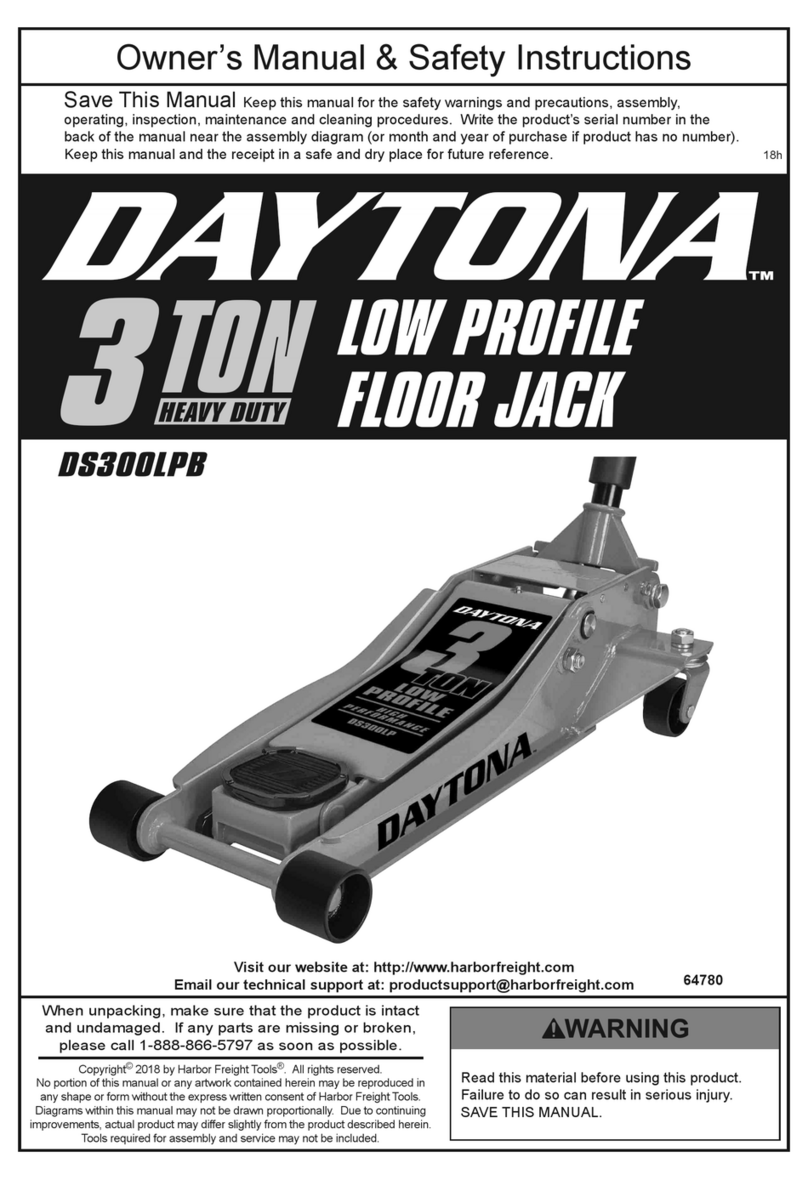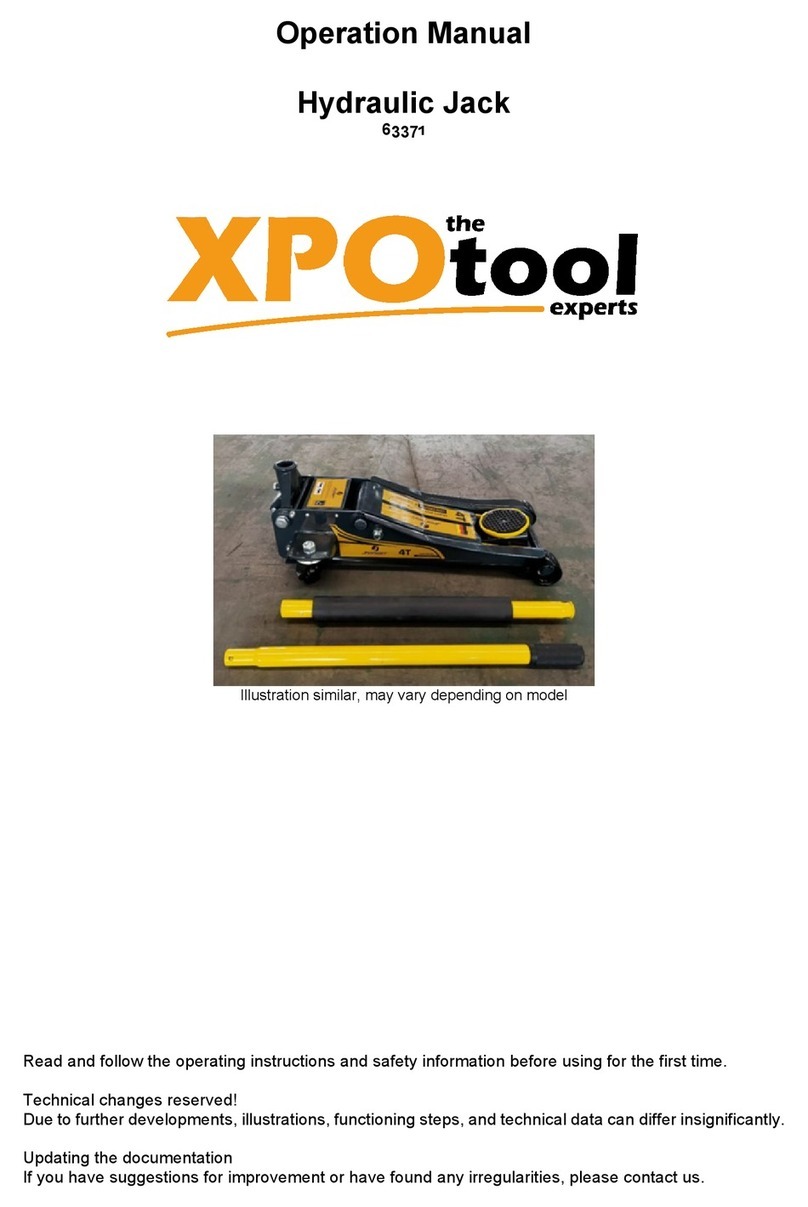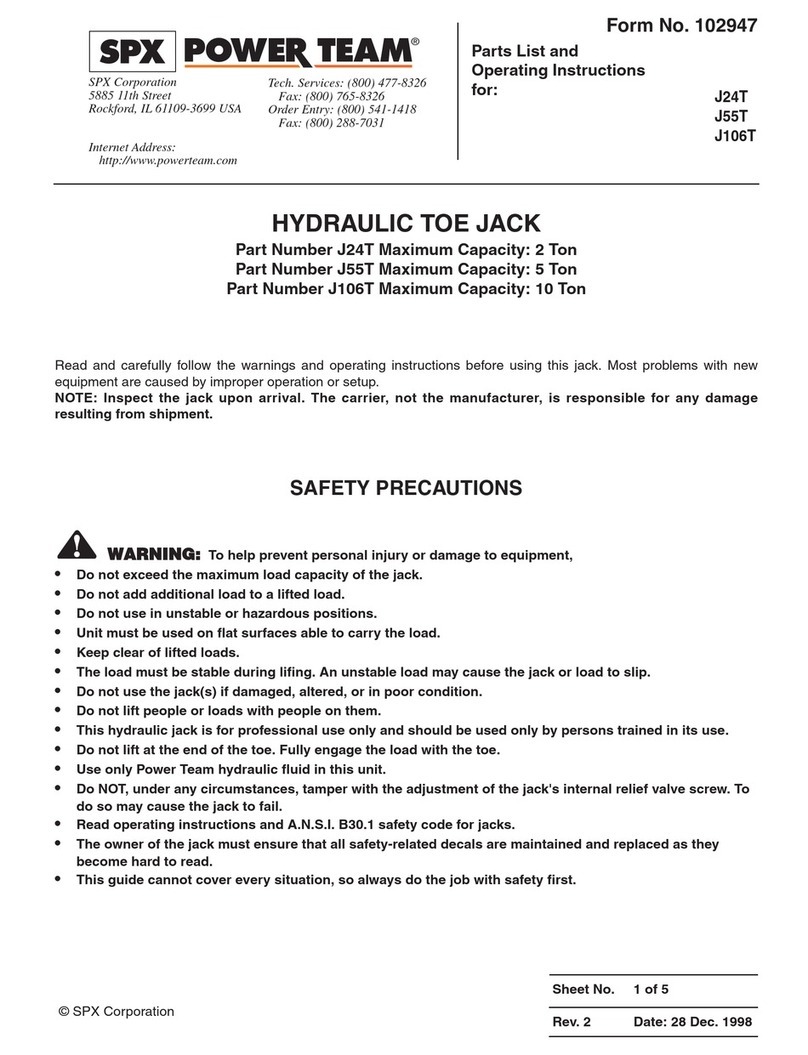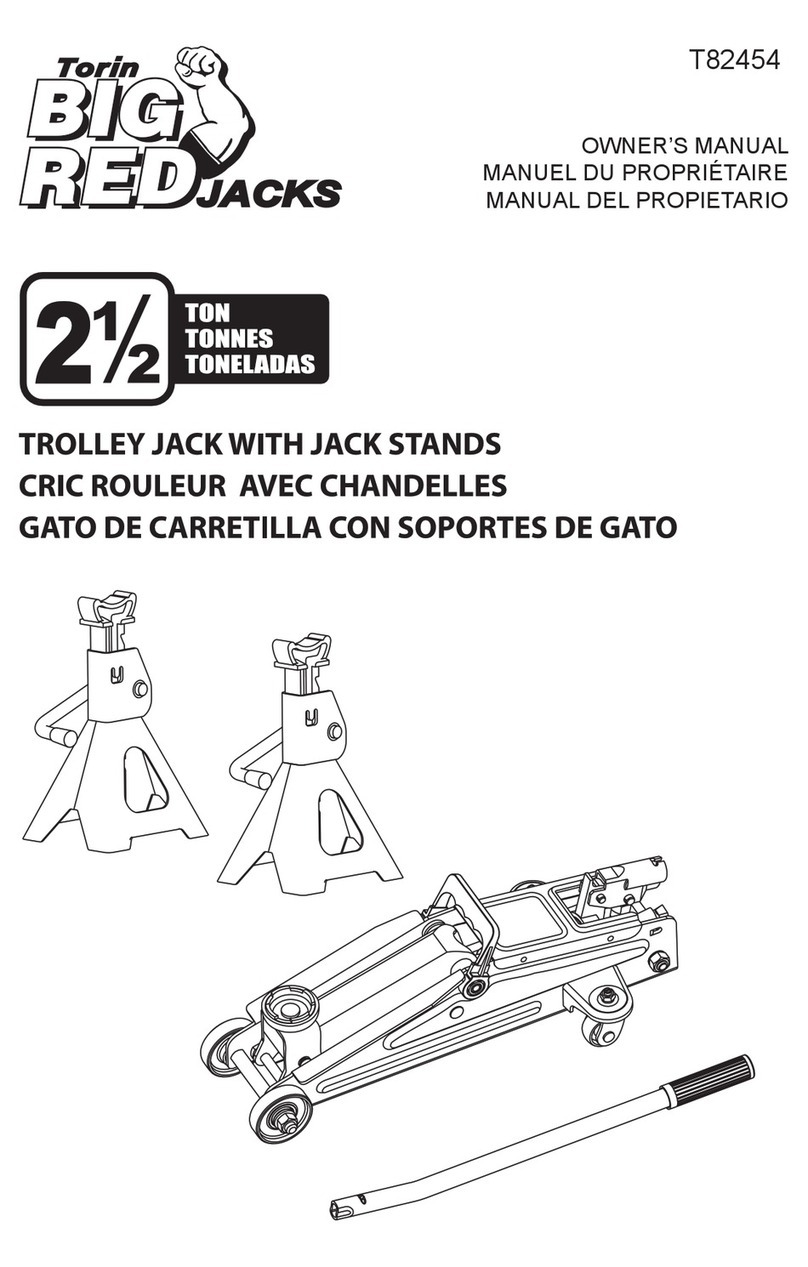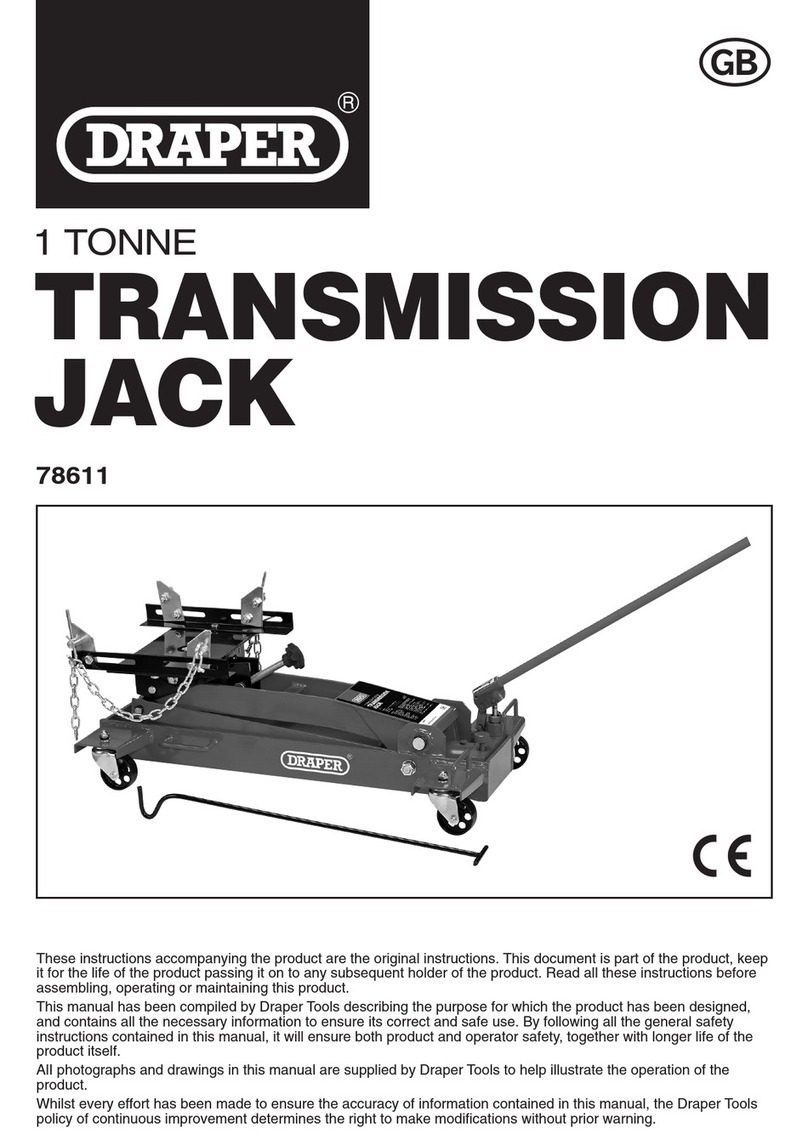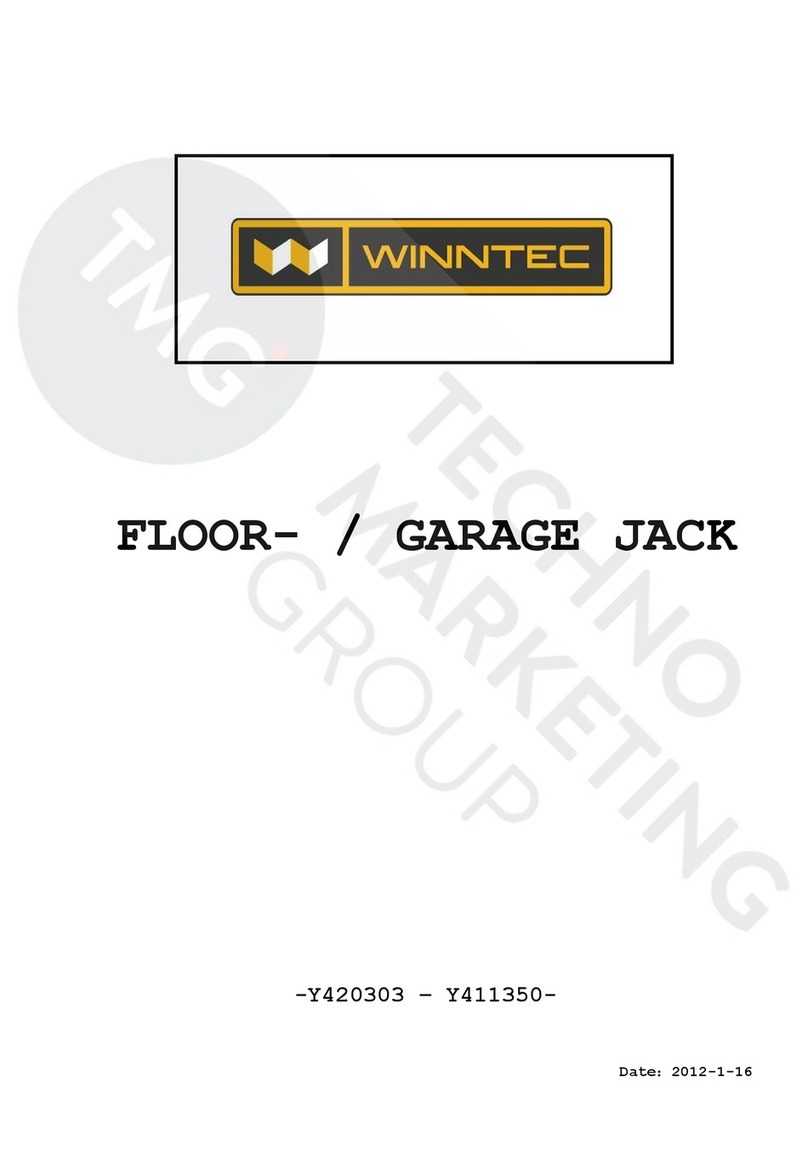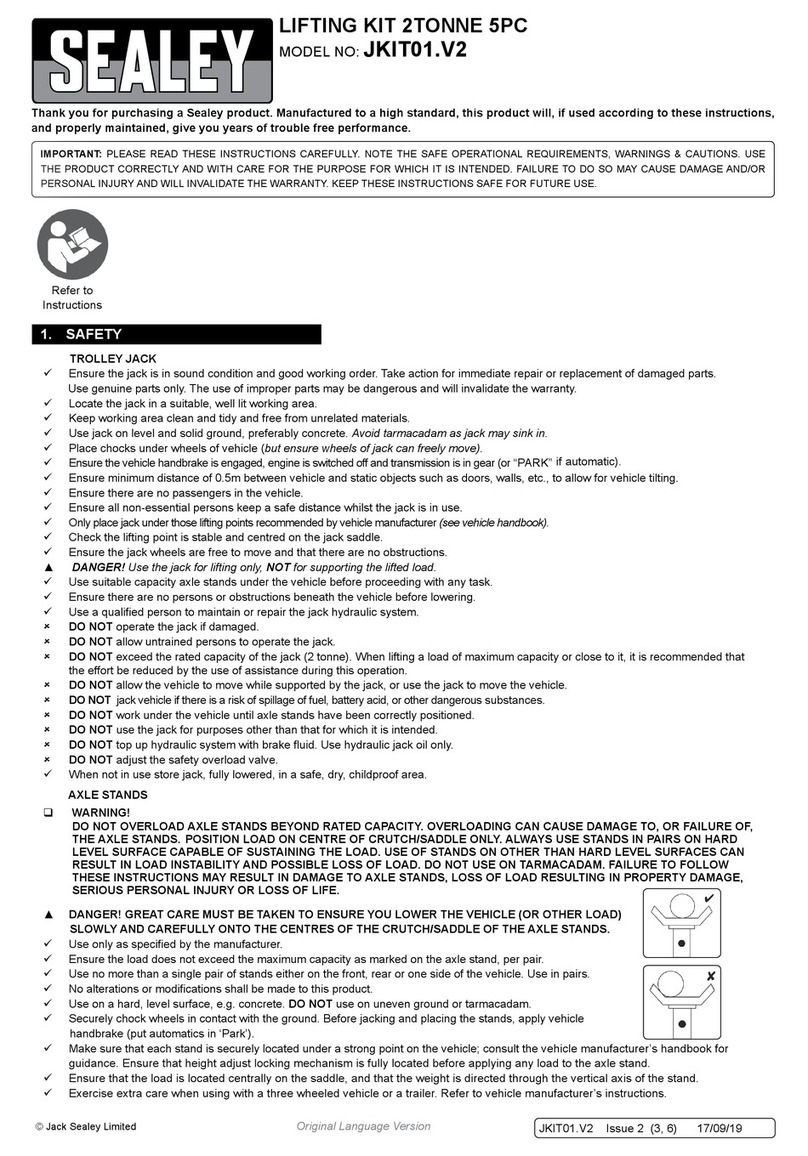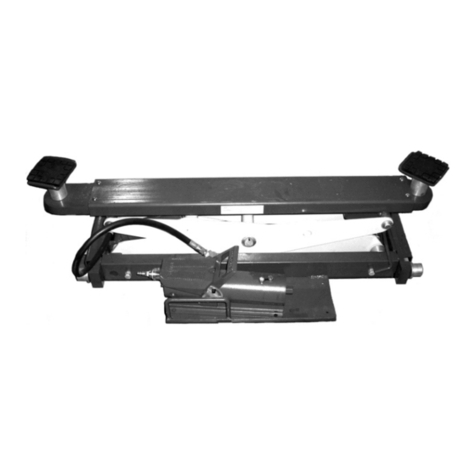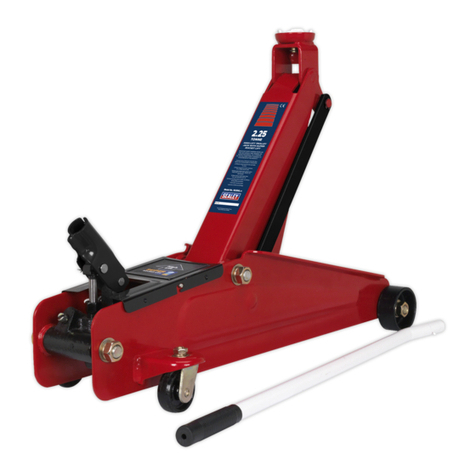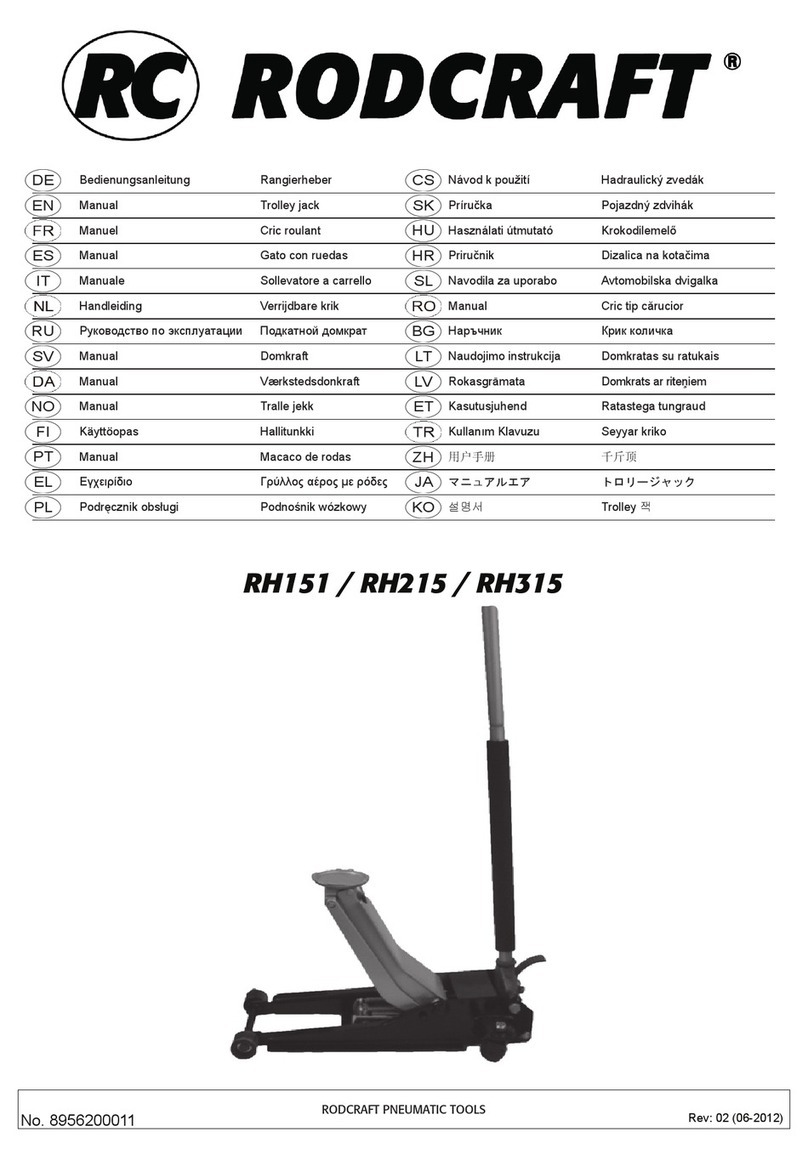BIG RED JACKS T90203B User manual

OWNER’S MANUAL
HYDRAULIC WELDED BOTTLE JACK
Questions, problems, missing parts? Before returning to your retailer, call our customer service department at
1-888-44-TORIN (1-888-448-6746), 8 a.m.- 5 p.m., PST, Monday-Friday.
Read carefully and understand all ASSEMBLY AND OPERATION INSTRUCTIONS before operating. Failure
to follow the safety rules and other basic safety precautions may result in serious personal injury.
Item.: T90203B T90213 T90403B T90413 T90603B T90613 T90803B T91003B T91203B T92003B
08152018Version

2
IMPORTANT
OWNER / USER RESPONSIBILITY
INTENDED USE
TECHNICAL SPECIFICATIONS
Before You Begin Register This Product.
For future reference, record the model name, model number, date of manufacture and purchase date of this
product. You can nd this information on the product.
Model Name ___________________
___
__
Model Number ________________________
Date of Manufacture ____________________
___
_
Date of Purchase ________________________
DO NOT OPERATE OR REPAIR THIS PRODUCT WITHOUT READING THIS MANUAL.
Read and follow the safety instructions. Keep Instructions readily available for operators. Make certain all
operators are properly trained and understand how to safely and correctly operate the product. By proceeding
you agree that you fully understand and comprehend the full contents of this manual. Failure to operate this
product as intended may cause injury or death. The manufacturer is not responsible for any damages or injury
caused by improper use or neglect. Allow product operation only with all parts in place and operating safely.
Use only genuine replacement parts. Service and maintain the product only with authorized or approved
replacement parts; negligence will make the product unsafe for use and will void the warranty. Carefully
inspect the product on a regular basis and perform all maintenance as required. Store these instructions
in a protected dry location. Keep all decals on the product clean and visible. Do not modify and/or use for
any application other than that for which this product was designed. If you have any questions relative to a
particular application, DO NOT use the product until you have rst contacted the distributor or manufacturer to
determine if it can or should be performed on the product.
For technical questions please call 1-888-448-6746.
This Bottle Jack is designed for lifting. The jack can be used vertically or angled to 3 degrees from vertical
position. After lifting, loads must be immediately supported by jack stands. Each model is suitable for use in
lifting or positioning vehicles, machinery, houses and/or other building structures. These jacks comply with
ASME PASE Standards.
Item Capacity Lifting Range
Min. (inch)
Lifting Range
Max. (inch)
Lifting Range
Min. (cm)
Lifting Range
Max. (cm)
T90203B / T90213
T90403B / T90413
T90603B / T90613
T90803B
T91003B
T91203B
T92003B
2 TON
4 TON
6 TON
8 TON
10 TON
12 TON
20 TON
6-7/8
7-1/2
8-1/4
8-13/16
8-13/16
9
9-7/16
13-1/4
14-5/16
15-15/16
17-5/8
17-5/8
18
17-5/8
17.5
19
21
22.5
22.5
23
24
33.8
36.5
40.5
45
45
46
45

3
GENERAL SAFETY RULES
JACK USE AND CARE
INSPECTION
GENERAL SAFETY RULES
IMPORTANT SAFETY CONSIDERATIONS
WARNING: Read and understand all instructions. Failure to follow all instructions listed below may
result in serious injury.
WARNING: The warnings, cautions, and instructions discussed in this instruction manual cannot
cover all possible conditions or situations that could occur. It must be understood by the operator
that common sense and caution are factors that cannot be built into this product, but must be supplied by
the operator.
CAUTION: Do not allow persons to operate or assemble this jack until they have read this manual
and have developed a thorough understanding of how the jack works.
DO NOT OPERATE OR REPAIR THIS EQUIPMENT WITHOUT READING THIS MANUAL.
To maintain the Service Jack and user safety, the responsibility of the owner is to read and follow these
instructions.
• Inspect the service jack for proper operation and function.
• Keep instructions readily available for equipment operators.
• Make certain all equipment operators are properly trained; understand how to safely and correctly operate
the unit.
• Allow unit operation only with all parts in place and operating properly.
• Use only genuine replacement parts.
• Service and maintain the unit only with authorized or approved replacement parts; negligence will make the
jack unsafe for use and void the warranty.
• Carefully inspect the unit on a regular basis and perform all maintenance as required.
• Store these instructions in the handle of your jack.
• Keep all decals on the unit clean and visible.
• Inspect the jack carefully before each use. Ensure the jack is not damaged, excessively worn, or missing
parts.
• Do not use the jack unless it is properly lubricated.
• Using a jack that is not in good clean working condition or properly lubricated may cause serious injury.
• Inspect the work area before each use. Make sure it is free and clear of any potential hazards.
• Do not modify the Jack in any way. Unauthorized modication may impair the function and/or safety and
could affect the life of the equipment. There are specic applications for which the Jack was designed.
• Always check for damaged or worn out parts before using the Jack. Broken parts will affect the Jack
operation. Replace or repair damaged or worn parts immediately.
• Store idle Jack. When Jack is not in use, store it in a secure place out of the reach of children. Inspect it for
good working condition prior to storage and before re-use.
• Not for use by children or people with reduced mental capacity.
• Do not use under the inuence of drugs or alcohol.
• Ensure children and other bystanders are kept at a safe distance when using product.

4
SAFETY
SAFETY MARKINGS
Always follow safety precautions when installing and operating this jack. Keep all decals on the unit clean and
visible. Before proceeding ensure that you fully understand and comprehend the full contents of this manual.
Failure to operate this equipment as directed may cause injury or death. The distributor is not responsible for
any damages or injury caused by improper use or neglect.
Always use Jack Stands!
DO NOT USE wood blocks or any other non-approved load sustaining devices. The manufacturer only
warrants loads to be sustained by jack stands that meet current ASME standards.
DO NOT USE wood blocks or any other non-approved lifting devices for a means of lifting with the jack and or
load being raised. Failure to head these warnings may cause injury or death.
THIS IS A LIFTING DEVICE ONLY!
• This jack is designed only for lifting part of the total vehicle.
• Do not move or dolly the vehicle while on the jack.
• The vehicle must be supported after lifting immediately by appropriately rated jack stands.
• NEVER go under a vehicle that is not supported with appropriately rated jacks stands.
• Use wheel chocks or other blocking device on opposing wheels before using jack stands.
WARNING!
WARNING!
1. Study, understand, and follow all instructions before operating this device.
2. Do not exceed rated capacity.
3. Use only on hard, level surfaces, with less than 3 degrees of slope.
4. Lifting device only. Immediately after lifting, support the vehicle with appropriate means.
5. Do not move or dolly the vehicle while on the jack.
6. Lift only on areas of the vehicle as specied by the vehicle manufacturer.
7. No alterations shall be made to this product.
8. Only attachments and/or adapters supplied by the manufacturer shall be used.
9. Do not get under or allow anyone under the vehicle until it has been supported by jack stands.
10. Center load on saddle prior to lifting.
11. Use wheel chocks or other blocking device on opposing wheels before using jack.
12. Never use on a lawn mower or lawn tractor.
13. Do not use this jack for any use other than the manufacturer specied usage.
14. Do not rock the vehicle while working on or around equipment.
15. The following are not recommended for supporting on this equipment: Foundations, Homes, Mobile
Homes, Trailers, RV’s, Campers, nor Fifth Wheels, etc...
16. Failure to heed these markings may result in personal injury and/or property damage.

5
GENERAL SAFETY INSTRUCTIONS
Position the Jack
Position the jack to only lift on the areas of the vehicle as specied by the vehicle manufacturer.
Always Use Jack Stands
After lifting the vehicle always support the load with appropriately rated vehicle jack stands before working on
the vehicle.
Do Not Overload Jack
Do not overload this jack beyond its rated capacity. Overloading this jack beyond its rated capacity can cause
damage to or failure of the jack.
Always Use on Hard Level Surfaces
This jack is designed only for use on hard level surfaces capable of sustaining the load. Use on other than
hard level surfaces can result in jack instability and possible loss of load.
Chock and Block (Stabilize)
Apply parking brake in vehicle before operating jack.
A chock is a wedge for steadying an object and holding it motionless, or for preventing the movement of a
wheel. Chock the wheel opposite the end being lifted.
When you block a load, you secure and support a load that is being lifted. The block(s) or stabilizer(s) should
have a weight capacity that is greater than the weight of the load which is being lifted.
Center Load on Jack Saddle
Center load on jack saddle before lifting vehicle.
Off-center loads and loads lifted when the jack is not level can cause loss of load or damage to the jack.
Do not raise or lower the vehicle unless tools, materials and people are clear.
When the lift is being lowered, make sure everyone is standing at least six feet away. Be sure there are no
tools or equipment left under or around the jack before lowering.
Always lower the jack slowly.
DO NOT USE THE JACK TO SUPPORT OR STABILIZE A LOAD.
Using the jack to support or stabilize a load may result in unexpected movement and result in serious injury,
being crushed and death. Always securely chock and block (stabilize) the load to be lifted. Never place any
part of the body under a raised load without properly chocking and supporting the load.
Never use the jack on curved or tubular vehicle
Bumpers. This will result in the vehicle slipping off the jack and falling, causing serious injury or death. Use a
bumper lift to lift most vehicles with curved bumpers of plastic bumpers.
Wear ANSI-approved safety glasses and heavy-duty work gloves during use.
Do not adjust the safety valve.
Do not move or dolly vehicle while jack is in use.
Stay alert. Use caution and common sense when operating jack. Do not use a jack when tired,
incoherent, dizzy, under the use of drugs or alcohol.
Training
Read this manual before use. Do not allow anyone who has not read this manual, and/or does not understand
the requirements, to use the jack.
Spectators
Do not allow bystanders around the jack or under the load supported only by the jack. Do not allow anyone in
the vehicle while the jack is in use. Keep all bystanders away from vehicle when in use.
Inspection
Inspect the jack carefully before each use. Ensure the jack is not damaged, excessively worn, or missing
parts. Do not use the jack unless it is properly lubricated. Using a jack that is not in good clean working
condition or properly lubricated may cause serious injury.
Additional Notes:
Save the receipt, warranty and these instructions.
Do not modify the jack in any way. Unauthorized modication may impair the function and/or safety and
could affect the life of the equipment. There are specic applications for which the jack was designed.
Always check for damaged or worn out parts before using the jack. Broken parts will affect the
equipment operation. Replace or repair damaged or worn parts immediately.
When jack is not in use, store it in a secure place out of the reach of children. Inspect it for good working
condition prior to storage and before re-use.

6
ASSEMBLY
SYSTEM AIR PURGE PROCEDURE
1. Familiarize yourself with the jack.
2. Attach the 2 handle pieces making sure to align
the holes on both sections.
1. Turn release valve counterclockwise on full turn to
the open position.
FIGURE 1 - Typical Bottle Jack
Ram
Saddle
Extension
Screw
Release
Valve
Handle
Sleeve
Handle
Assembly
Oil Plug
(on reservior)
IMPORTANT: BEFORE FIRST USE
Perform the following System Air Purge Procedure to
remove any air that may have been introduced into
the hydraulic system as a result of product shipment
and handling. This step is to be completed without
any weight on the jack.
3. Line up the handle to the handle socket located
on the side of the jack. Then insert the handle
inside the handle socket.
4. Secure the handle in place inside the handle
socket. Without any vehicle on the jack. Cycle
the lift up and down several times to insure the
hydraulic system is operating properly. (Perform
the System Air Purge Procedure before rst use.)

7
2. Rapidly pump the handle 6-8 times. Leave handle
in down position to expose oil ll plug.
4. Turn release valve clockwise to the closed
position.
5. Jack is now ready for use. Check for proper pump
action.
7. Before raising the vehicle double check and verify
the saddle is centered and also has full contact
with the lifting point.
RAISING THE JACK
1. Block the vehicle’s wheels for lifting stability.
Secure the load to prevent inadvertent shifting
and movement.
2. Position the jack near desired lift point.
3. Set the Parking Brake in the vehicle.
4. Refer to the vehicle manufacturer owner’s manual
to locate approved lifting points on the vehicle.
Position the jack so that the saddle is centered
and will contact the load lifting point rmly.
5. Assemble the handle, ensure that spring clips
align with slots.
6. Close the release valve by turning it clockwise
until it is rmly closed.
BEFORE USE
3. With a at blade screwdriver, push the oil ll plug
slightly to the side to purge trapped air from
system. (Use caution not to tear or puncture the
oil plug.)
1. Before using this product, read the owner's
manual completely and familiarize yourself
thoroughly with the product and the hazards
associated with its improper use.
2. Perform the system air purge procedure. (See
previous instructions for System Air Purge
Procedure.)
3. Check that the pump operates smoothly before
putting into service.
4. Inspect before each use. Do not use if bent,
broken or cracked components are noted.

8
LOWERING THE JACK
WARNING: USE EXTREME CAUTION
WHEN LOWERING THE JACK. THE JACK
HANDLE MAY TURN RAPIDLY. OPENING
THE RELEASE VALVE TO FAST CAN CAUSE
THE JACK TO LOWER RAPIDLY. FAILURE TO
HEAD THESE WARNINGS COULD CAUSE
SERIOUS INJURY OR DEATH.
8. Pump handle to lift until saddle contacts load.
Continue to pump the jack handle to lift the
vehicle to the desired height. After lifting, support
the load with appropriately rated vehicle support
stands before working on the vehicle.
2. Remove support stands.
3. Grasp the handle rmly with both hands. Securely
hold on to the jack handle so your hands do not
slip and ensure the release valve does not rapidly
lower.
4. Carefully open the Release Valve by slowly
turning the handle counterclockwise. (Do not
allow bystanders around the jack or under the
load when lowering the jack.)
5. After removing jack from under the load, push ram
and handle sleeve down to reduce exposure to
rust and contamination.
1. Raise load high enough to allow clearance for the
jack stands to be removed, then carefully remove
jack stands.
CAUTION: NEVER WIRE, CLAMP OR
OTHERWISE DISABLE THE LIFT CONTROL
VALVE TO FUNCTION BY ANY MEANS
OTHER THAN BY USING THE OPERATOR'S
HAND. USE THE HANDLE PROVIDED WITH
THIS PRODUCT OR AN AUTHORIZED
REPLACEMENGT HANDLE TO ENSURE
PROPER RELEASE VAVLE OPERATION. DO
NOT USE EXTENSIONS ON THE AIR HOSE
OR ON THE OPERATING HANDLE.

9
MAINTENANCE INSTRUCTIONS
If you use and maintain your equipment properly, it will give you many years of service. Follow the
maintenance instructions carefully to keep your equipment in good working condition. Never perform any
maintenance on the equipment while it is under a load.
Inspection
You should inspect the product for damage, wear, broken or missing parts (e.g.: pins) and that all components
function before each use. Follow lubrication and storage instructions for optimum product performance.
Binding
If the product binds while under a load, use equipment with equal or a larger load capacity to lower the load
safely to the ground. After unbinding; clean, lubricate and test that equipment is working properly. Rusty
components, dirt, or worn parts can be causes of binding. Clean and lubricate the equipment as indicated in
the lubrication section. Test the equipment by lifting without a load. If the binding continues contact Customer
Service.
Cleaning
If the moving parts of the equipment are obstructed, use cleaning solvent or another good degreaser to clean
the equipment. Remove any existing rust, with a penetrating lubricant.
Lubrication
This equipment will not operate safely without proper lubrication. Using the equipment without proper
lubrication will result in poor performance and damage to the equipment. Some parts in this equipment are not
self-lubricating. Inspect the equipment before use and lubricate when necessary. After cleaning, lubricate the
equipment using light penetrating oil, lubricating spray.
• Use a good lubricant on all moving parts.
• For light duty use lubrication once a month.
• For heavy and constant use lubrication recommended every week.
• NEVER USE SANDPAPER OR ABRASIVE MATERIAL ON THESE SURFACES!
Rust Prevention:
Check rams and pump plungers on the power unit assemblies daily for any signs of rust or corrosion.
Without a load, lift the equipment as high as it goes and look under and behind the lifting points. If signs of
rust are visible clean as needed.
Grease Fittings
Some models contain grease ttings that will regularly need to be greased and lubricated.
How the Jack Operates
With release valve closed, an upward stroke of the jack handle draws oil from the reservoir tank into the
plunger cavity. Hydraulic pressure holds the valve closed, which keeps the oil in the plunger cavity. A
downward stroke of the jack handle releases oil into the cylinder, which forces the ram out. This raises the
saddle. When the ram reaches maximum extension, oil is bypassed back into the reservoir to prevent an over
extended ram stroke and possible damage to the jack. Opening the release valve allows oil to ow back into
reservoir. This releases hydraulic pressure on the ram, which results in lowering the saddle.
Storing the Jack
1. Lower the Lifting ram.
2. Place the handle in the upright position.
3. Store in a dry location, recommended indoors.
Note: If the jack is stored outdoors, be sure to lubricate all parts before and after use to ensure the jack stays
in good working condition. Always store jack in the fully retracted postion when stored in outdoor or caustic
enviroments that can cause corrosion and/or rust.

10
TO ADD JACK OIL
TO REPLACE JACK OIL
1. Position the jack on level ground and lower the
saddle.
1. Position the jack on level ground and lower the
saddle.
2. Open release valve by turning handle counter-
clockwise (4 full turns).
2. Remove the oil plug.
3. Fill the oil case until oil level is just beneath the
lower rim of the oil ll hole.
4. Replace oil plug.
5. Perform the System Air Purge Procedure.
*SEE ASSEMBLY IMAGE FOR JACK OIL
RESEVOIR LOCATION.

11
3. Remove the oil ll plug. 7. Replace oil plug.
4. Turn the jack on its side so that old oil will drain
from the oil ll hole.
5. Position the jack on level ground and lower the
saddle.
6. Fill the oil case until oil level is just beneath the
lower rim.
KEEP DIRT AND OTHER MATERIAL CLEAR
WHEN POURING.
• DO NOT USE MOTOR OIL IN THE JACK.
• ONLY USE ANTI-FOAMING JACK OIL.
• ALWAYS USE A GOOD GRADE HYDRAULIC
JACK OIL.
• DO NOT USE HYDRAULIC BRAKE FLUID,
ALCOHOL, GLYCERINE, DETERGENT, MOTOR
OIL OR DIRTY OIL.
• USE OF A NON-RECOMMENDED FLUID CAN
CAUSE DAMAGE TO A JACK.
• AVOID MIXING DIFFERENT TYPES OF FLUID
AND NEVER USE BRAKE FLUID, TURBINE
OIL, TRANSMISSION FLUID, MOTOR OIL OR
GLYCERIN. IMPROPER FLUID CAN CAUSE
PREMATURE FAILURE OF THE JACK AND THE
POTENTIAL FOR SUDDEN AND IMMEDIATE
LOSS OF LOAD.
• DISPOSE OF HYDRAULIC FLUID IN
ACCORDANCE WITH LOCAL REGULATIONS.
ADDITIONAL LUBRICATION:
1. Periodically check the pump piston and ram for
signs of rust or corrosion. Clean as needed and
wipe with an oil cloth. NEVER USE SANDPAPER
OR ABRASIVE MATERIAL ON THESE
SURFACES!
2. When not in use, store the jack with pump piston
and ram fully retracted.
ADDITIONAL WARNINGS:
8. Perform the System Air Purge Procedure.
* SEE ASSEMBLY IMAGE FOR JACK OIL
RESEVOIR LOCATION.

12
ASSEMBLY DIAGRAM

13
Ref. T90203B / T90213 T90403B / T90413 T90603B / T90613 T90803B / T91003B T91203B T92003B Description Qty
1 Roundwire snap ring 1
2 Rectangular ring 2
3 O-Ring 1
4 Ram assembly 1
5 Bowl washer 1
6 O-Ring 1
7 Roundwire snap ring 1
8 Base welding parts 1
9 TF1201C-29 TF1201C-29 TF1201C-29 TF1201C-29 TF1201C-29 TF1201C-29 Oil plug 1
10 GB308-6 GB308-6 GB308-6 GB308-6 GB308-6 GB308-6 Steel ball 6mm 1
11 T90403-25(ASM) T90403-25(ASM) T90403-25(ASM) T90403-25(ASM) T90403-25(ASM) T90403-25(ASM) Release valve assembly 1
12 Plastic plug 1
13 Safety Valve 1
14 Spring 1
15 Spring holder 1
16 Steel ball 3mm 1
17 Steel ball 5mm 2
18 Bowl washer 1
19 TH92004-4(ASM) TH92004-4(ASM) TH92004-4(ASM) TH92004-4(ASM) TH92004-4(ASM) TH92004-4(ASM) Pump plunger assembly 1
20 QLQD2B.2-5 QLQD2B.2-5 QLQD2B.2-5 QLQD2B.2-5 QLQD2B.2-5 QLQD2B.2-5 Cotter pin 2
21 T90403-19 T90403-19 T90403-19 T90403-19 T90403-19 T90403-19 Pin 2
22 T90403-22(ASM) T90403-22(ASM) T90403-22(ASM) T90403-22(ASM) T90403-22(ASM) T90403-22(ASM) Handle socket assembly 1
23 T90203-31(ASM) T90203-31(ASM) T90603-31(ASM) T91203-31(ASM) T91203-31(ASM) T91203-31(ASM) Handle assembly 1
24 TH90204.MF TH90404.MF TH90604.MF TH91004.MF TH91204.MF TH92004.MF Seal kit 1

14
TROUBLESHOOTING
WARRANTY NOTICE
WARRANTY INFORMATION
JACK
WILL
NOT
LIFT
LOAD
JACK
WILL
NOT
HOLD
LOAD
JACK
WILL
NOT
LOWER
POOR
JACK
LIFTING
WILL NOT
LIFT TO
FULL
EXTENSION
CAUSES AND SOLUTIONS
Release valve is not completely closed
(Turn handle clockwise).
Weight Capacity Exceeded.
Air is in the hydraulics.
Purge air from system.
Low oil level. Add oil as required.
Oil reservoir is overlled.
Drain excessive oil.
Lubricate moving parts.
Jack is binding or foreign obstruction
Power unit malfunctioning.
Replace the power unit.
X XX
X
X X
X X XX
X X X
X
X
Safe Operating Temperature is between 40°F – 105°F (4°C - 41°C)
This bottle jack is covered under a 1-year limited warranty when used as recommended. Only those items
listed with a Part # are available for purchase. For assistance with the operation or the availability of
replacement parts, contact our Parts and Warranty Department at 1-888-44-TORIN (1-888-448-6746). Please
have available a copy of your receipt, the model number of the product, serial number, and specic details
regarding your question.
Not all equipment components are available for replacement; illustrations provided are a convenient reference
of location and position in the assembly sequence.
The manufacturer reserves the rights to make design changes and or improvements to product lines
and manuals without notice.
We want to know If you have any concerns with our products. If so, please call toll-free for Immediate
assistance. For additional web customer support help inquiries visit the Customer Service section at:
http://www.torin-usa.com.

15
TORIN ONE YEAR LIMITED WARRANTY
Torin Inc.® has been producing quality automotive repair and maintenance products since 1968. All products
sold are felt to be of the highest quality and are covered by the following warranty:
With proof of purchase for a period of one year from the date of that purchase, the manufacturer will repair
or replace, at its discretion, without charge, any of its products or parts thereof which fail due to a defect in
material or workmanship. This warranty does not cover damage or defects caused by improper use, careless
use or abuse of the equipment. This warranty does not cover parts normally considered to wear out or be
consumed in the normal operation of the equipment. Except where such limitations and exclusions are
specically prohibited by applicable law, (1) the CONSUMERS SOLE AND EXCLUSIVE REMEDY SHALL BE
THE REPAIR OR REPLACEMENT OF DEFECTIVE PRODUCTS AS DESCRIBED ABOVE, and (2) THE
MANUFACTURER SHALL NOT BE LIABLE FOR ANY CONSEQUENTIAL OR INCIDENTAL DAMAGE
OR LOSS WHATSOEVER, and (3) THE DURATION OF ANY AND ALL EXPRESSED AND IMPLIED
WARRANTIES, INCLUDING, WITHOUT LIMITATION, ANY WARRANTIES OF MERCHANTABILITY AND
FITNESS FOR A PARTICULAR PURPOSE, IS LIMITED TO A PERIOD OF ONE YEAR FROM DATE OF
PURCHASE. Product alteration in any manner by anyone other than us, with the sole exception of alterations
made pursuant to product instructions and in a workman like manner. You acknowledge and agree that any
use of the product for any purpose other than the specied use(s) stated in the product instructions is at Your
own risk.
Always check for damaged or worn out parts before using any product. Broken parts will affect the equipment
operation. Replace or repair damaged or worn parts immediately. Do not modify the product in any way.
Unauthorized modication may impair the function and/or safety and could affect the life of the equipment.
There are specic applications for which products are designed and tested during production. Manufacturer
provided warranted items are not authorized to be repaired by anyone other than the manufacturer or
manufacture approved repair person. Distributor does not have authorization to amend these statements. You
acknowledge and agree that any modification of the product for any purpose other than manufacturer
completed repairs is at your own risk. Before using this product, read the owner's manual completely and
familiarize yourself thoroughly with the product and the hazards associated with its improper use.
IMPORTANT: BEFORE FIRST USE on any Lift verify that a daily inspection has been completed and that all
components are in the proper working order.
This limited warranty gives you specic legal rights, and you also may have other rights, which vary from
state to state. Some states do not allow limitations or exclusions on implied warranties or incidental or
consequential damages, so the above limitations may not apply to You. This limited warranty is governed
by the laws of the State of California, without regard to rules pertaining to conicts of law. The state courts
located in San Bernardino County, California shall have exclusive jurisdiction for any disputes relating to this
warranty.
Manufacturer reserves the rights to make design changes and or improvements to this product lines and
manual without notice. We at Torin have taken every effort to ensure complete and accurate instructions
have been included in this manual. However, possible product updates, revisions and or changes may
have occurred since this printing. Torin Inc. reserves the right to change specications without incurring any
obligation for equipment previously or subsequently sold. Not responsible for typographical errors.
Alternately Customer Service can be reached through www.torin-usa.com or via email at
Not all equipment components are available for replacement, but are illustrated as a convenient reference of
location and position in the assembly sequence. Contact Customer Service for equivalent component. When
you contact us, please have your Product’s Model number, Serial Number and Description ready so that we
may help you efciently. This information can be found on a sticker on the product.
For any warranty support or if your Torin® equipment is not functioning properly contact
Torin® Customer Service directly by telephone at 1-888-44-TORIN (1-888-448-6746)
8:00am – 5:00pm Pacic Time, Monday – Friday
www.torin-usa.com Made in China

MANUEL DU PROPRIÉTAIRE
CRIC-BOUTEILLE HYDRAULIQUE
SOUDÉ
Questions, problèmes, pièces manquantes? Avant de retourner voir votre fournisseur, appelez notre service à
la clientèle au 1-888-44-TORIN (1-888-448-6746) entre 8 heures et 17 heures, HNP, du lundi au vendredi.
Lisez attentivement et comprenez toutes les DIRECTIVES DE MONTAGE ET DE FONCTIONNEMENT avant
l’utilisation. Vous pouvez subir des blessures graves si vous ne vous conformez pas à ces règles et autres
précautions de sécurité.
AVERTISSEMENT!
Article No.: T90203B T90213 T90403B T90413 T90603B T90613 T90803B T91003B T91203B T92003B

17
UTILISATION PRÉVUE
SPÉCIFICATIONS TECHNIQUES
Ce cric-bouteille est conçu pour le levage. Le cric peut être utilisé à la verticale ou à un angle de 3 degrés
de la verticale. Les charges doivent être supportées par des chandelles après le levage. Chaque modèle
convient au levage ou au positionnement des véhicules, de la machinerie, des maisons ou autres structures
de bâtiments. Ces crics sont conformes aux normes ASME PASE.
IMPORTANT
RESPONSABILITÉ DU PROPRIÉTAIRE OU DE L’UTILISATEUR
Avant de commencer, enregistrez ce produit.
Pour référence future, enregistrez le nom de modèle, le numéro, la date de fabrication et la date d’achat du
produit. Vous pouvez trouver ces renseignements sur le produit.
Nom de modèle _______________________
Numéro de modèle _______________________
Date de fabrication _______________________
Date d’achat _______________________
NE PAS UTILISER OU RÉPARER CE PRODUIT SANS AVOIR LU LE PRÉSENT MANUEL.
Lisez et suivez les directives de sécurité. Conservez ces directives à la disponibilité des opérateurs.
Assurez-vous que tous les opérateurs sont bien formés et savent comment utiliser le produit correctement et
en toute sécurité. En continuant, vous convenez que vous comprenez complètement le contenu du présent
manuel. Le produit peut causer des blessures ou provoquer la mort si vous n’utilisez pas le produit dans le
but pour lequel il a été conçu. Le fabricant n’est pas responsable des dommages ou blessures provoquées
par une utilisation inappropriée ou par négligence. Ne faites fonctionner le produit que si toutes les pièces
sont en place et fonctionnent de manière sécuritaire. N’utilisez que des pièces de rechange authentiques.
Effectuez l’entretien de ce produit uniquement avec des pièces de rechange autorisées ou approuvées; la
négligence rendra l’utilisation du produit dangereuse et annulera la garantie. Inspectez régulièrement et avec
soin le produit et effectuez tout l’entretien nécessaire. Conservez ces directives dans un endroit protégé sec.
Conservez propres et visibles tous les autocollants sur le produit. Ne modiez pas ou n’utilisez pas le produit
pour une application autre que celle pour laquelle il a été conçu. Pour toute question relative à une application
particulière, N’utilisez PAS le produit avant d’avoir communiqué avec le distributeur ou le fabricant an de
déterminer si cela peut se faire.
Pour toutes questions d’ordre technique, appelez au 1-888-448-6746.
Article No. Capacité
Amplitude de
levage Min.
(Pouce)
Amplitude de
levage Max.
(Pouce)
Amplitude de
levage Min.
(cm)
Amplitude de
levage Max.
(cm)
T90203B / T90213 2 TONNES 6 7/8 13 1/4 17,5 33,8
T90403B/ T90413 4 TONNES 7 1/2 14 5/16 19 36,5
T90603B/ T90613 6 TONNES 8 1/4 15 15/16 21 40,5
T90803B 8 TONNES 8 13/16 17 5/8 22,5 45
T91003B 10 TONNES 8 13/16 17 5/8 22,5 45
T91203B 12 TONNES 9 18 23 46
T92003B 20 TONNES 9 7/16 17 5/8 24 45

18
RÈGLES GÉNÉRALES DE SÉCURITÉ
UTILISATION ET SOINS À DONNER AU CRIC
INSPECTION
CONSIGNES GÉNÉRALES DE SÉCURITÉ
FACTEURS DE SÉCURITÉ IMPORTANTS
AVERTISSEMENT : Lisez et comprenez toutes les instructions. Si vous ne suivez pas les instructions
mentionnées ci-dessous, il peut en résulter des blessures graves.
AVERTISSEMENT : Les avertissements, mises en garde et directives mentionnés dans le présent
manuel d’instruction ne peuvent pas couvrir toutes les conditions ou situations qui peuvent se
produire. L’opérateur doit bien comprendre que le bon sens et la prudence sont des facteurs qui ne
peuvent pas être incorporés dans ce produit, mais doivent être fournis par l’opérateur.
MISE EN GARDE : Ne permettez à personne d’utiliser ou d’assembler ce cric avant d’avoir lu le
manuel et d’avoir bien compris le fonctionnement du cric.
NE PAS UTILISER OU RÉPARER CE PRODUIT SANS AVOIR LU LE PRÉSENT MANUEL.
Le propriétaire est responsable de lire et de se conformer à ces instructions pour l’entretien du cric de service
et le maintient de la sécurité de l’utilisateur.
• Inspectez le cric de service pour vérier s’il fonctionne bien.
• Gardez ces instructions à la disponibilité des opérateurs d’équipement.
• Assurez-vous que tous les opérateurs d’équipement sont bien formés, qu’ils savent bien faire fonctionner
l’appareil en toute sécurité.
• Ne permettez l’utilisation de l’unité que si toutes les pièces sont en place et fonctionnent bien.
• Utilisez uniquement des pièces de rechange d’origine.
• N’effectuez l’entretien et la maintenance de l’appareil qu’à l’aide de pièces de rechange autorisées ou
approuvées; la négligence rendra le cric dangereux et annulera la garantie.
• Inspectez l’appareil avec soin sur une base régulière et effectuez tout entretien nécessaire.
• Conservez les présentes instructions dans la poignée du cric.
• Toutes les étiquettes doivent être propres et visibles.
• Inspectez avec soin le cric avant chaque utilisation. Assurez-vous que le cric n’est pas endommagé, trop
usé ou que des pièces y manquent.
• N’utilisez pas le cric à moins qu’il ne soit sufsamment lubrié.
• L’emploi d’un cric qui n’est pas en bon état et bien lubrié peut provoquer des blessures graves.
• Inspectez l’aire de travail avant chaque utilisation. Assurez-vous qu’elle est libre de tous dangers potentiels.
• Ne modiez d’aucune façon le cric. Une modication non autorisée peut compromettre la fonction ou la
sécurité et pourrait inuer sur la durée de vie de l’équipement. Le cric a été conçu pour des applications
précises.
• Avant d’utiliser le cric, vérifiez toujours pour vous assurer que les pièces ne soient pas
endommagées ou usées. Les pièces brisées inuent sur le fonctionnement du cric. Remplacez ou réparez
immédiatement les pièces endommagées ou usées.
• Rangez un cric non utilisé. Lorsque le cric n’est pas utilisé, rangez-le dans un endroit sûr, hors de portée
des enfants. Inspectez-le pour voir s’il est bon état avant de le ranger et avant de le réutiliser.
• Ne doit pas être utilisé par des enfants ou des personnes mentalement décientes.
• Ne pas utiliser sous l’inuence de l’alcool ou des drogues.
• Assurez-vous que les enfants et autres spectateurs se trouvent à une distance acceptable lors de
l’utilisation du produit.

19
SÉCURITÉ
MARQUAGES DE SÉCURITÉ
Conformez-vous toujours aux précautions de sécurité lors de l’installation et du fonctionnement de ce cric.
Gardez toutes les étiquettes propres et visibles. Avant l’utilisation, assurez-vous que vous comprenez
tout le contenu du présent manuel. Si vous ne faites pas fonctionner cet équipement de la façon selon les
instructions, cela peut provoquer des blessures et même la mort. Le distributeur n’est pas responsable des
dommages ou blessures causés par l’utilisation inappropriée ou la négligence.
Utilisez toujours des chandelles de levage!
N’UTILISEZ PAS de blocs de bois ou tous autres dispositifs de support de charge non approuvés. Le
fabricant garantit uniquement les charges supportées par les chandelles qui sont conformes aux normes
ASME actuelles.
N’UTILISEZ PAS de blocs de bois ou tous autres dispositifs de levage non approuvés comme moyen de
levage à l’aide du cric ou de la charge à lever. Il peut en résulter des blessures ou la mort si vous ne suivez
pas ces avertissements.
CET APPAREIL SERT UNIQUEMENT AU LEVAGE ET À LA TRACTION!
• Ce cric est conçu uniquement pour le levage d’une partie du véhicule.
• Ne déplacez pas le véhicule ou ne le tirez pas sur chariot pendant qu’il est supporté sur
cric.
• Le véhicule doit être supporté immédiatement après le levage à l’aide de chandelles de
capacité sufsante.
• NE JAMAIS aller sous un véhicule qui n’est pas supporté par des chandelles de levage de
capacité sufsante.
• Avant d’utiliser des chandelles de levage, placez des cales de roues ou un dispositif de
blocage sur les roues opposées.
AVERTISSEMENT!
AVERTISSEMENT!
1. Étudiez, comprenez et suivez toutes les consignes avant d’utiliser cet appareil.
2. N’en dépassez pas la capacité nominale.
3. Utilisez uniquement sur surfaces dures et de niveau comportant une pente d’au plus 3 degrés.
4. Appareil de levage seulement. Supportez le véhicule de façon appropriée immédiatement après le
levage.
5. Ne déplacez pas le véhicule ou ne le tirez pas sur chariot pendant qu’il est supporté sur cric.
6. Soulevez un véhicule en ces seuls points spéciés par le constructeur du véhicule.
7. Aucunes modications ne doivent être apportées à ce produit.
8. Seules les xations ou adaptateurs fournis par le fabricant seront utilisés.
9. Ne vous placez pas et ne laissez personne se placer sous le véhicule jusqu’à ce qu’il soit supporté par
des chandelles de levage.
10. Centrez la charge sur la sellette avant le levage.
11. Avant d’utiliser des chandelles de levage, placez des cales de roues ou un dispositif de blocage sur les
roues opposées.
12. N’utilisez jamais de chandelles pour une tondeuse ou un tracteur de jardin.
13. N’utilisez pas ce cric pour une utilisation autre que celle spéciée par le fabricant.
14. Ne faites pas balancer le véhicular pendant que des travaux sont en train d’être effectués sur ou autour
de l’équipement.
15. Il n’est pas recommendé de supporter l’équipement sur les suivants: fondations, maisons, maisons
mobiles, caravanes, VR, camping-cars, semi-caravanes, etc
16. Il peut en résulter des blessures ou des dommages si vous ne suivez pas ces consignes.

20
CONSIGNES GÉNÉRALES DE SÉCURITÉ
Positionner le cric
Positionnez le cric pour ne soulever que ces parties du véhicules qui sont spéciées par le constructeur du
véhicule.
Toujours utiliser des chandelles de levage
Après avoir soulevé le véhicule, soutenez toujours la charge avec des chandelles de support de véhicule
convenables avant de travailler dans le véhicule.
Ne pas surcharger le cric
Ne surchargez pas le cric au-delà de sa capacité nominale. La surcharge du cric au-delà de sa capacité
nominale peut provoquer des dommages ou une défaillance du cric.
Utiliser toujours sur des surfaces dures et de niveau
Ce circ est conçu uniquement pour utilisation sur des surfaces dures et de niveau capables de supporter la
charge. Si le cric est utilisé sur des surfaces qui ne soient pas dures et plates, il peut devenir instable et il
peut entraîner la perte de la charge.
Calage et blocage (stabiliser)
Appliquez le frein de stationnement du véhicule avant d’utiliser le cric.
Une cale est un coin pour stabiliser un objet et le maintenir immobile, ou pour prévenir le mouvement d’une
roue. Calez la roue qui se trouve à l’extrémité contraire de celle qui est levée.
Lorsque vous bloquez une charge, vous xez et supportez une charge qui est soulevée. Les blocs ou
stabilisateurs devraient avoir une capacité pondérale supérieure au poids de la charge soulevée.
Centrer la charge sur la sellette du cric
Centrez la charge sur la sellette du cric avant de lever le véhicule.
Les charges décentrées ou les charges soulevées lorsque le cric n’est pas de niveau peuvent provoquer une
perte de la charge ou endommager le cric.
Ne soulevez pas ou n’abaissez pas le véhicule à moins que les outils, les matériaux et les personnes soient
dégagés.
Lorsque le cric est abaissé, assurez-vous que toutes les personnes soient éloignées d’au moins six pieds.
Assurez-vous qu’il n’y a pas d’outils ou d’équipement laissé sous ou autour du cric avant d’abaisser le
véhicule.
Abaissez toujours le cric lentement.
N’UTILISEZ PAS LE CRIC POUR SUPPORTER OU STABILISER UNE CHARGE.
L’utilisation du cric pour supporter ou stabiliser une charge peut provoquer un déplacement inattendu et
provoquer des blessures graves, un écrasement et la mort. Calez ou bloquez (stabilisez) toujours de manière
sécuritaire la charge à soulever. Ne placez jamais une partie du corps sous une charge soulevée sans avoir
calé et supporté adéquatement la charge.
N’utilisez jamais le cric sur des pare-chocs incurvés ou tubulaires.
Cela peut provoquer un glissement du véhicule hors du cric et le faire tomber, provoquant ainsi des blessures
ou la mort. Utilisez des appareils de levage pour pare-chocs pour soulever les véhicules munis de pare-chocs
incurvés ou en plastique.
Portez des lunettes de sécurité homologuées ANSI ainsi que des gants de travail résistants lors de
l’utilisation du cric.
Ne réglez pas la soupape de sécurité.
Ne déplacez pas le véhicule ou ne le tirez pas sur chariot pendant que le cric est utilisé.
Soyez vigilant. Soyez prudent et utilisez votre bon sens lorsque vous utilisez le cric. N’utilisez pas le
cric lorsque vous êtes fatigué, incohérent, étourdi, sous l’emprise des drogues ou de l’alcool.
Formation
Lisez le présent manuel avant d’utiliser le cric. Ne permettez à personne d’utiliser le cric si elle n’a pas lu le
manuel ou n’en comprend pas les exigences.
Spectateurs
Ne laissez pas qu’il y ait des spectateurs autour du cric ou sous la charge supportée seulement par le cric.
Inspection
Examinez le cric soigneusement avant chaque usage. Assurez-vous que le cric ne soit pas endommagé, avec
une usure excessive, ou qu’il y ait des pièces manquantes.
N’utilisez pas le cric à moins qu’il ne soit sufsamment lubrié. L’emploi d’un cric qui n’est pas en bon état et
bien lubrié peut provoquer des blessures graves.
Remarques supplémentaires :
Conservez le reçu, la garantie et les présentes instructions.
Ne modiez d’aucune façon le cric. Une modication non autorisée peut nuire au fonctionnement ou à la
sécurité et peut inuer sur la durée de vie de l’équipement. Le cric a été conçu pour des applications précises.
Avant d’utiliser le cric, vériez toujours s’il y a des pièces endommagées ou usées. Des pièces brisées
inueront sur le fonctionnement de l’équipement. Remplacez et réparez immédiatement les pièces
endommagées ou usées.
Lorsque le cric n’est pas utilisé, rangez-le dans un endroit sûr, hors de portée des enfants. Vériez-en l’état
avant l’entreposage et une nouvelle utilisation.
This manual suits for next models
9
Table of contents
Languages:
Other BIG RED JACKS Jack manuals
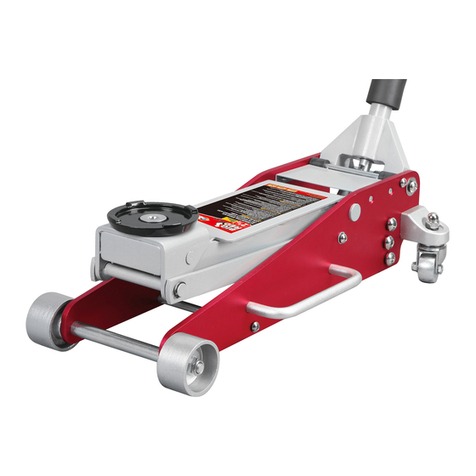
BIG RED JACKS
BIG RED JACKS Torin T84025B User manual
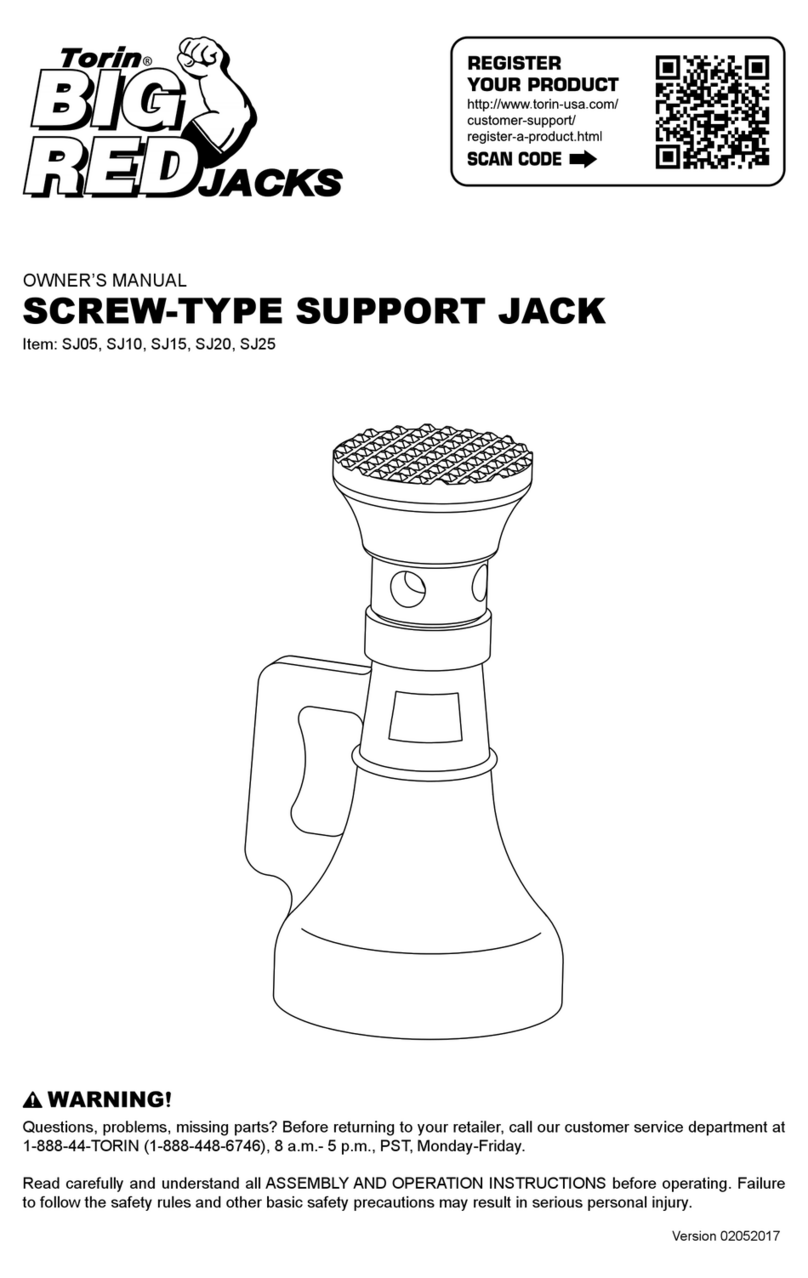
BIG RED JACKS
BIG RED JACKS SJ10 User manual
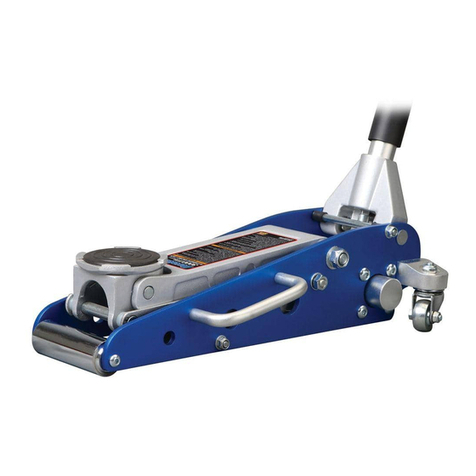
BIG RED JACKS
BIG RED JACKS T815005L User manual
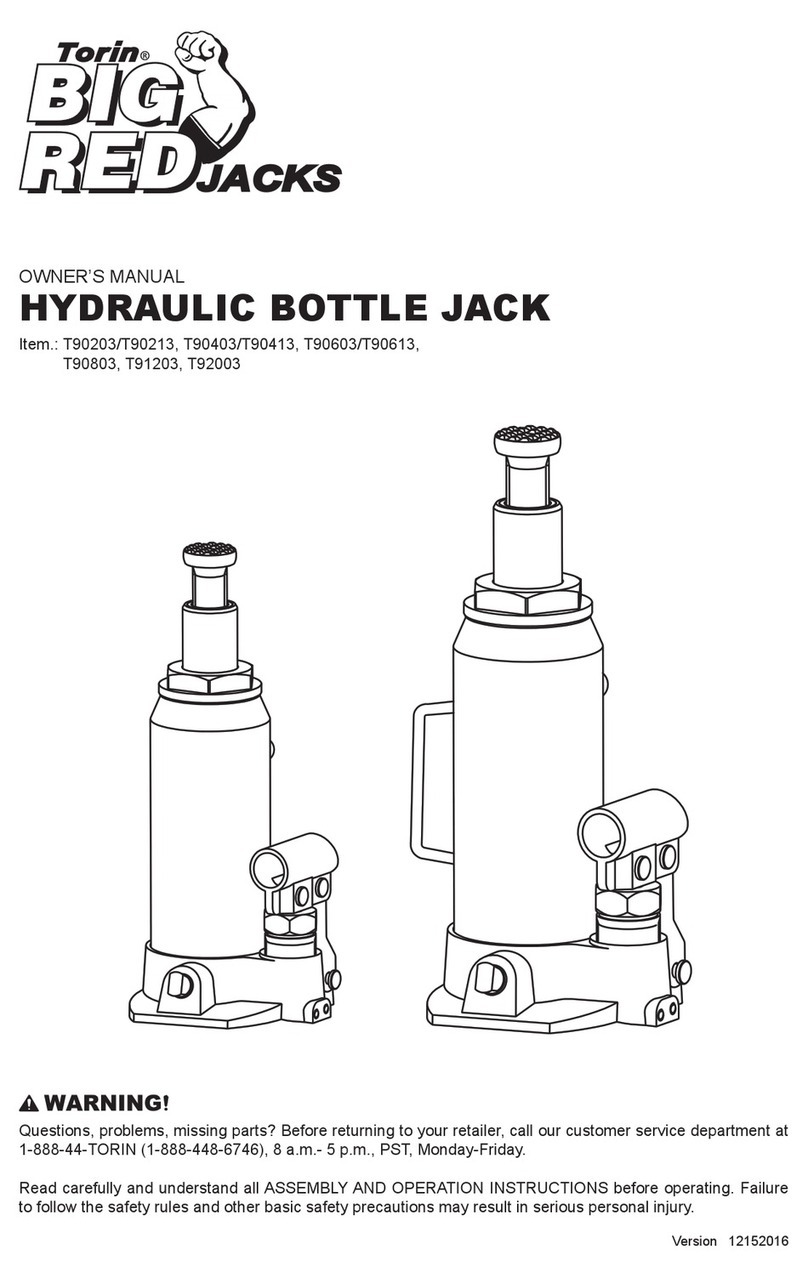
BIG RED JACKS
BIG RED JACKS T90203 User manual
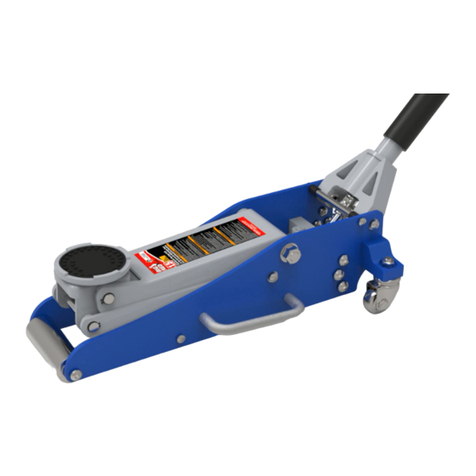
BIG RED JACKS
BIG RED JACKS Torin T815016CL User manual
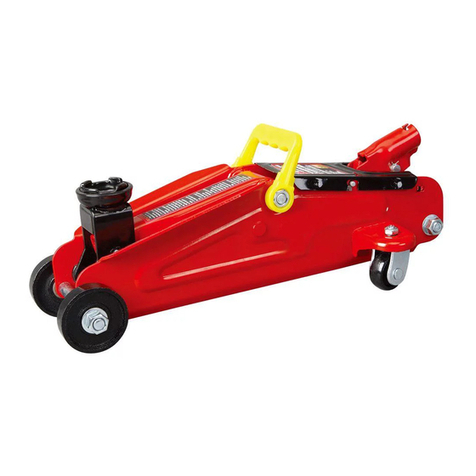
BIG RED JACKS
BIG RED JACKS T82002 User manual

BIG RED JACKS
BIG RED JACKS T42002 User manual
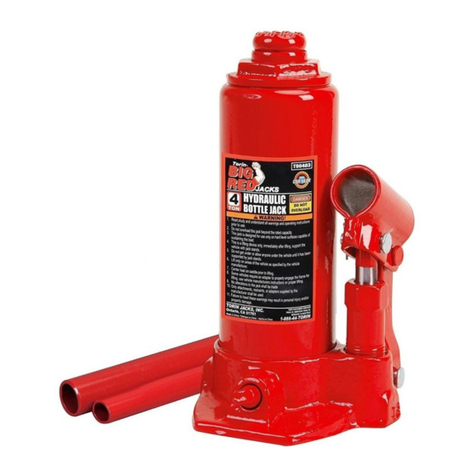
BIG RED JACKS
BIG RED JACKS 2T User manual
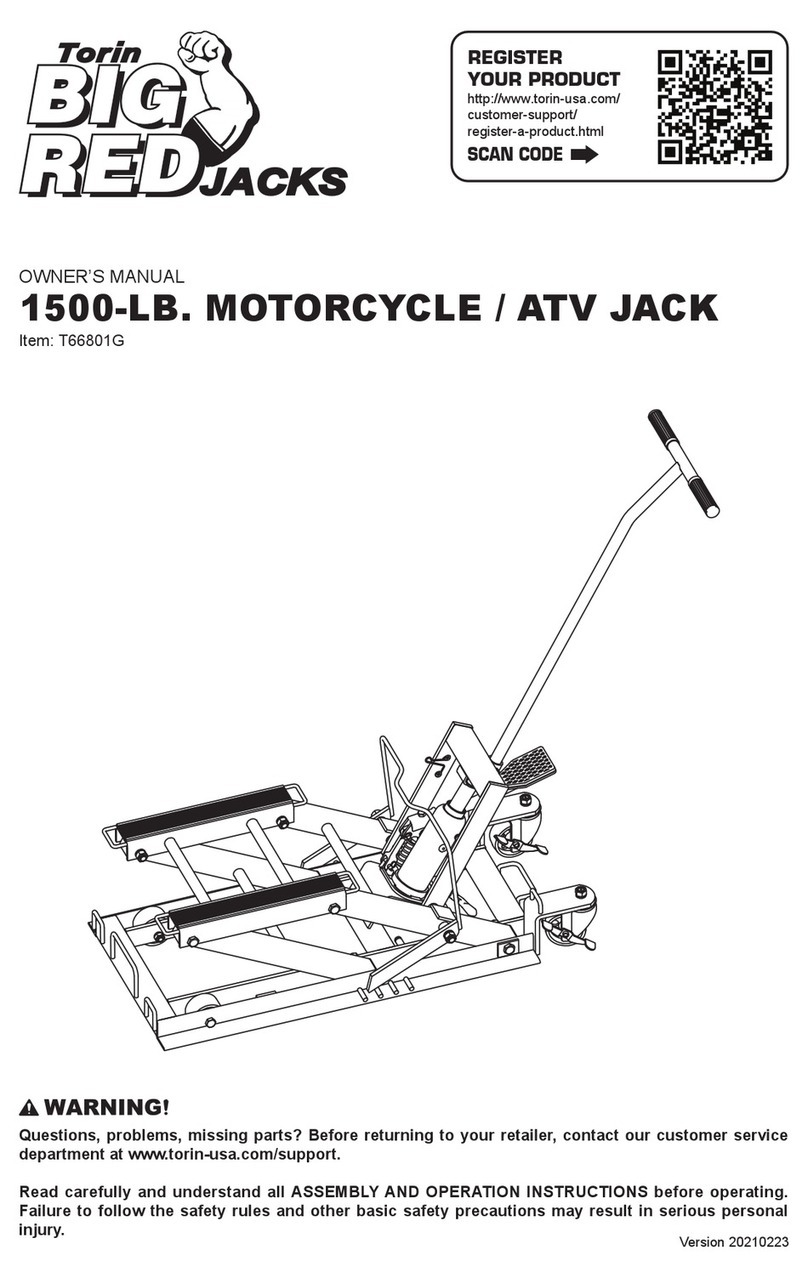
BIG RED JACKS
BIG RED JACKS T66801G User manual
